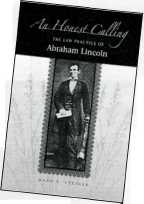 |
Home | Search | Browse | About IPO | Staff | Links |
 |
Home | Search | Browse | About IPO | Staff | Links |

Whig wag
An Honest Calling: Early on in his investigation of the missing gem in The Moonstone, Sergeant Cuff says of Betteridge, Wilkie Collins' loyal but obstructive house steward: "If this man only understood the growing of roses, he would be the most completely perfect character on the face of creation." While reading Mark F. Steiner's terrific new study of Abraham Lincoln's law practice, An Honest Calling, Sergeant Cuff's impractical and comical observation about the flawed house steward kept popping into my mind. Steiner's thesis—essentially that "Lincoln was a Whig before he was a lawyer" and a "Whig lawyer"—carries the author through a theoretical maze minding the details of Lincoln's pre-presidential professional life but leaves the reader with questions about the chasm between theory and the realty of the antebellum practice of law in central Illinois. In other words, if it wasn't so tightly coupled to its own thesis, Steiner's book would be remarkable. However, this gap—between the theoretical and the real—is the only, albeit glaring, miscalculation in Steiner's otherwise discerning study. Steiner begins his analysis with a thorough review of previous works concerning the lawyer Lincoln. Sifting the political from the merely partisan, differentiating between the dated and the incompetent, and giving credit mostly where credit is due, Steiner offers readers a precise history of Lincoln legal studies in a far too brief twenty or so pages. A reader could regret the author's decision to summarize his predecessors with such brevity because Steiner excels in reviewing the work of those who have attempted a task similar to his own. Steiner's articulate reflections on previous efforts establish his credibility. These pages are full of penetrating observations and refutations of previous positions and arguments about Lincoln's legal career and about the motives of those who have claimed the lawyer Lincoln as their own, and the author's knowledge of his subject matter prepares the groundwork for Steiner's narrative. 
Similarly, Steiner's treatment of Lincoln's peculiar legal education could have been more elaborate— especially to modern readers who are largely unaware of the course of legal education in rural Nineteenth Century America. With an uncomplicated, unaffected prose style, Steiner untangles the legal education of the "backwoods" antebellum lawyer and describes Lincoln's legal resources and informal law school. Steiner does a wonderful job explaining how the nature of Lincoln's legal education affected his practice and the method of the legal process in his day, and this engaging description of the legal atmosphere in which the lawyer Lincoln found himself is essential to any understanding of his law practice. In particular, Steiner explains the way in which Lincoln and some of his peers were forced to internalize Blackstone's Commentaries and other legal treatises and rely on them throughout their practices. The practice of law in antebellum America is ultimately disorienting to many, and Steiner's handling of this subject is an example of the best kind of scholarly work. It is in Steiner's chapter "A Whig in the Courthouse" where this reader first paused. Although Steiner is clear to explain time and time again that one should "not read too much into Lincoln's representation" of this or that client, he also seems to be struggling to impose a connection between Lincoln's pre-1855 political affiliation with the Whig Party and his professional calling and law practice. To Steiner, the ties suggest a broad-brush picture in which Lincoln's politics influenced his law practice and perhaps vice versa, but the story he expertly describes displays little more than the rise of a successful private practice attorney with a necessarily 25 diverse client base—a client base that changed dramatically over time. Certainly no one can take serious issue with Steiner's descriptions of Whig politics or Lincoln's gravitation to and sympathy with the Whig Party. However, what ultimately distills from this chapter is not so much a portrait of a 'Whig lawyer' but of a self-educated man who is both a Whig and a lawyer. It is this Chapter (and its lingering effects throughout the book) that led this reader to remember the words of Sergeant Cuff and wonder how perfect and useful this study might have been without its thesis. Perhaps Steiner's perception of the "Whigish attitude toward law," wherein a lawyer could represent any side in a dispute and use the court system as the neutral arbiter of disputes, is where the problem arises. As Lincoln's practice grew and as he began to represent corporate and out-of-state interests, Steiner sees Lincoln being forced to sacrifice his ideal as a "Whig lawyer." Lincoln's representation of the railroad, for instance, was one example where Lincoln was obligated to abandon the Whig "independence to represent any client, and to serve a mediative role" as a result of his client's "narrow interests." According to Steiner, this development and loss of autonomy "irritated" Lincoln, but the nexus drawn between the development of Lincoln's law practice and his forced abandonment of Whig ideals seems like a stretch. Steiner's tremendous ability to describe Lincoln's legal skills and his emerging legal prowess do not finally need a convenient "thesis" or theme, and the author's insistence on articulating this connection between Lincoln the Whig and Lincoln the lawyer blurs the narrative Steiner so eloquently, otherwise, develops. Roland R. Cross is a partner with the Springfield law firm of Brown, Hay & Stephens, LLP. He is a member of the Advisory Board of the Illinois State Historical Society. 26 |
|
|